Affordable Care Act, US Government, and Political Implications
VerifiedAdded on 2022/09/12
|8
|2123
|21
Essay
AI Summary
This essay examines the Affordable Care Act (ACA), also known as Obamacare, and its significant impact on the US government and healthcare policy. It explores the ACA's origins within the executive branch under President Obama and its implementation through a national structure involving both federal and state governments. The essay analyzes the role of checks and balances, highlighting the involvement of the legislative and judicial branches in shaping and interpreting the ACA. It further discusses the ACA's influence on elections, media perceptions, and voting behavior, particularly during the 2016 presidential election and ongoing political debates. The essay concludes by emphasizing the ACA's enduring importance in US politics and its potential impact on future elections, especially considering the context of the COVID-19 pandemic and the contrasting views of political candidates regarding healthcare reform. The analysis incorporates various scholarly sources to support its arguments, providing a comprehensive overview of the ACA's multifaceted influence.
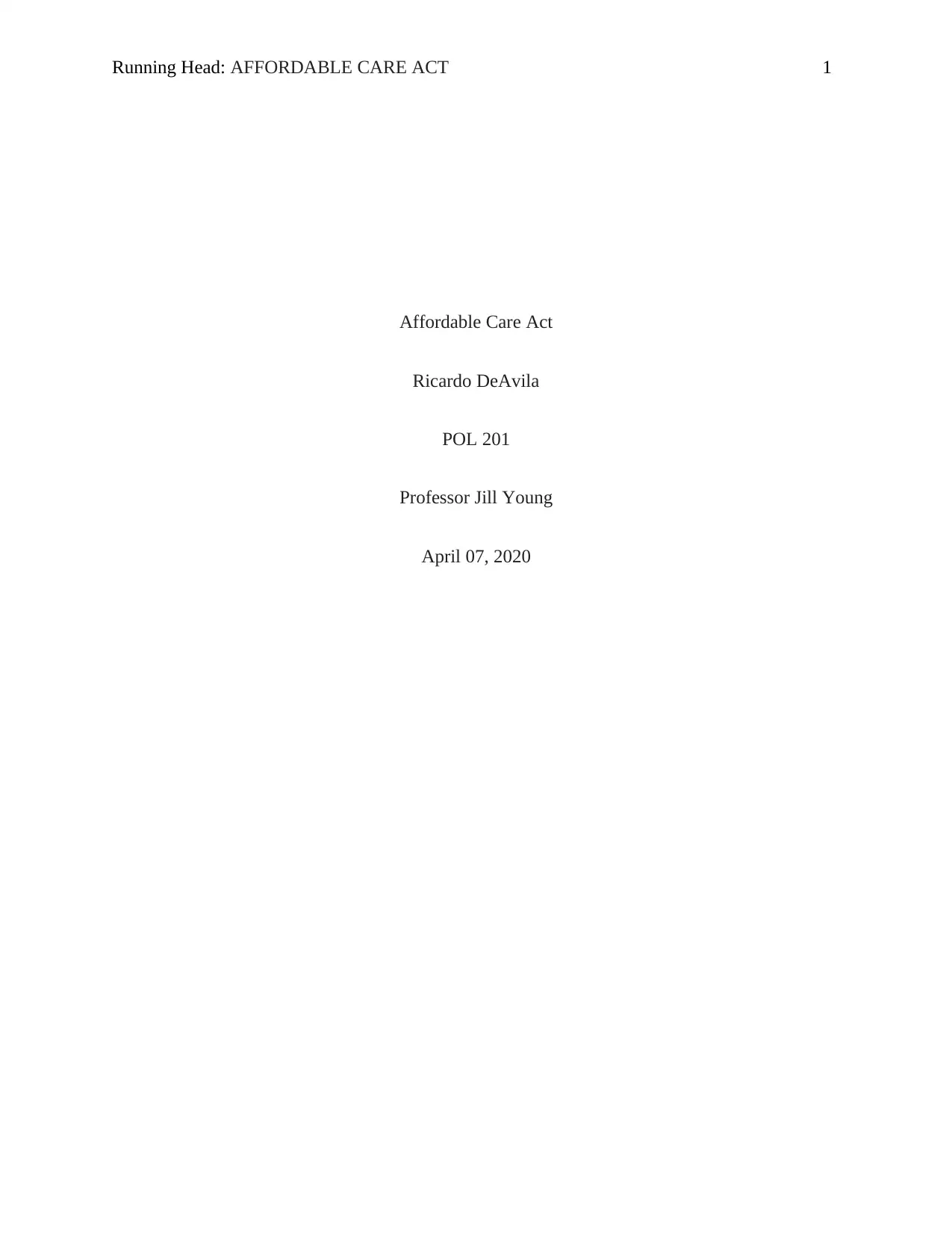
Running Head: AFFORDABLE CARE ACT 1
Affordable Care Act
Ricardo DeAvila
POL 201
Professor Jill Young
April 07, 2020
Affordable Care Act
Ricardo DeAvila
POL 201
Professor Jill Young
April 07, 2020
Paraphrase This Document
Need a fresh take? Get an instant paraphrase of this document with our AI Paraphraser
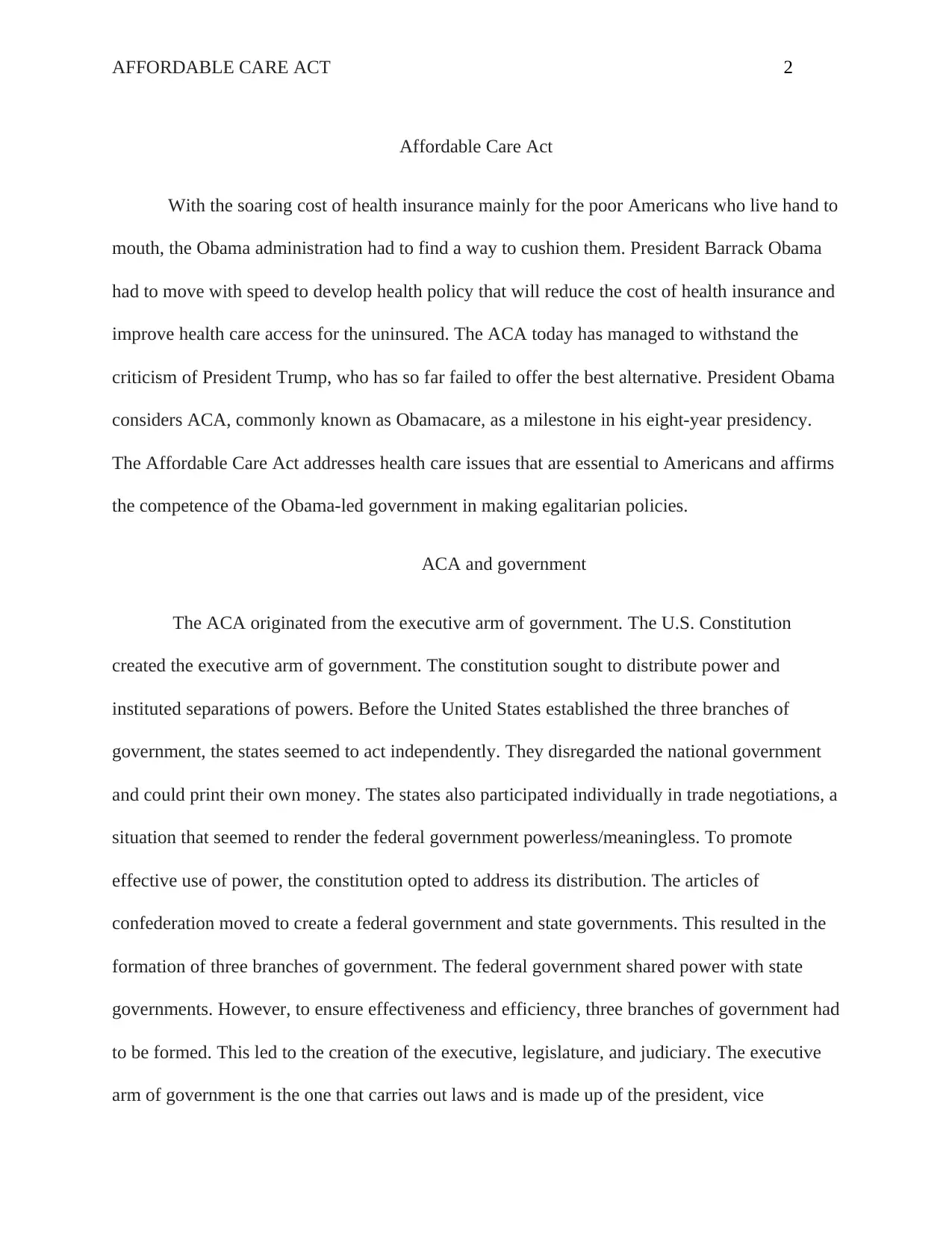
AFFORDABLE CARE ACT 2
Affordable Care Act
With the soaring cost of health insurance mainly for the poor Americans who live hand to
mouth, the Obama administration had to find a way to cushion them. President Barrack Obama
had to move with speed to develop health policy that will reduce the cost of health insurance and
improve health care access for the uninsured. The ACA today has managed to withstand the
criticism of President Trump, who has so far failed to offer the best alternative. President Obama
considers ACA, commonly known as Obamacare, as a milestone in his eight-year presidency.
The Affordable Care Act addresses health care issues that are essential to Americans and affirms
the competence of the Obama-led government in making egalitarian policies.
ACA and government
The ACA originated from the executive arm of government. The U.S. Constitution
created the executive arm of government. The constitution sought to distribute power and
instituted separations of powers. Before the United States established the three branches of
government, the states seemed to act independently. They disregarded the national government
and could print their own money. The states also participated individually in trade negotiations, a
situation that seemed to render the federal government powerless/meaningless. To promote
effective use of power, the constitution opted to address its distribution. The articles of
confederation moved to create a federal government and state governments. This resulted in the
formation of three branches of government. The federal government shared power with state
governments. However, to ensure effectiveness and efficiency, three branches of government had
to be formed. This led to the creation of the executive, legislature, and judiciary. The executive
arm of government is the one that carries out laws and is made up of the president, vice
Affordable Care Act
With the soaring cost of health insurance mainly for the poor Americans who live hand to
mouth, the Obama administration had to find a way to cushion them. President Barrack Obama
had to move with speed to develop health policy that will reduce the cost of health insurance and
improve health care access for the uninsured. The ACA today has managed to withstand the
criticism of President Trump, who has so far failed to offer the best alternative. President Obama
considers ACA, commonly known as Obamacare, as a milestone in his eight-year presidency.
The Affordable Care Act addresses health care issues that are essential to Americans and affirms
the competence of the Obama-led government in making egalitarian policies.
ACA and government
The ACA originated from the executive arm of government. The U.S. Constitution
created the executive arm of government. The constitution sought to distribute power and
instituted separations of powers. Before the United States established the three branches of
government, the states seemed to act independently. They disregarded the national government
and could print their own money. The states also participated individually in trade negotiations, a
situation that seemed to render the federal government powerless/meaningless. To promote
effective use of power, the constitution opted to address its distribution. The articles of
confederation moved to create a federal government and state governments. This resulted in the
formation of three branches of government. The federal government shared power with state
governments. However, to ensure effectiveness and efficiency, three branches of government had
to be formed. This led to the creation of the executive, legislature, and judiciary. The executive
arm of government is the one that carries out laws and is made up of the president, vice
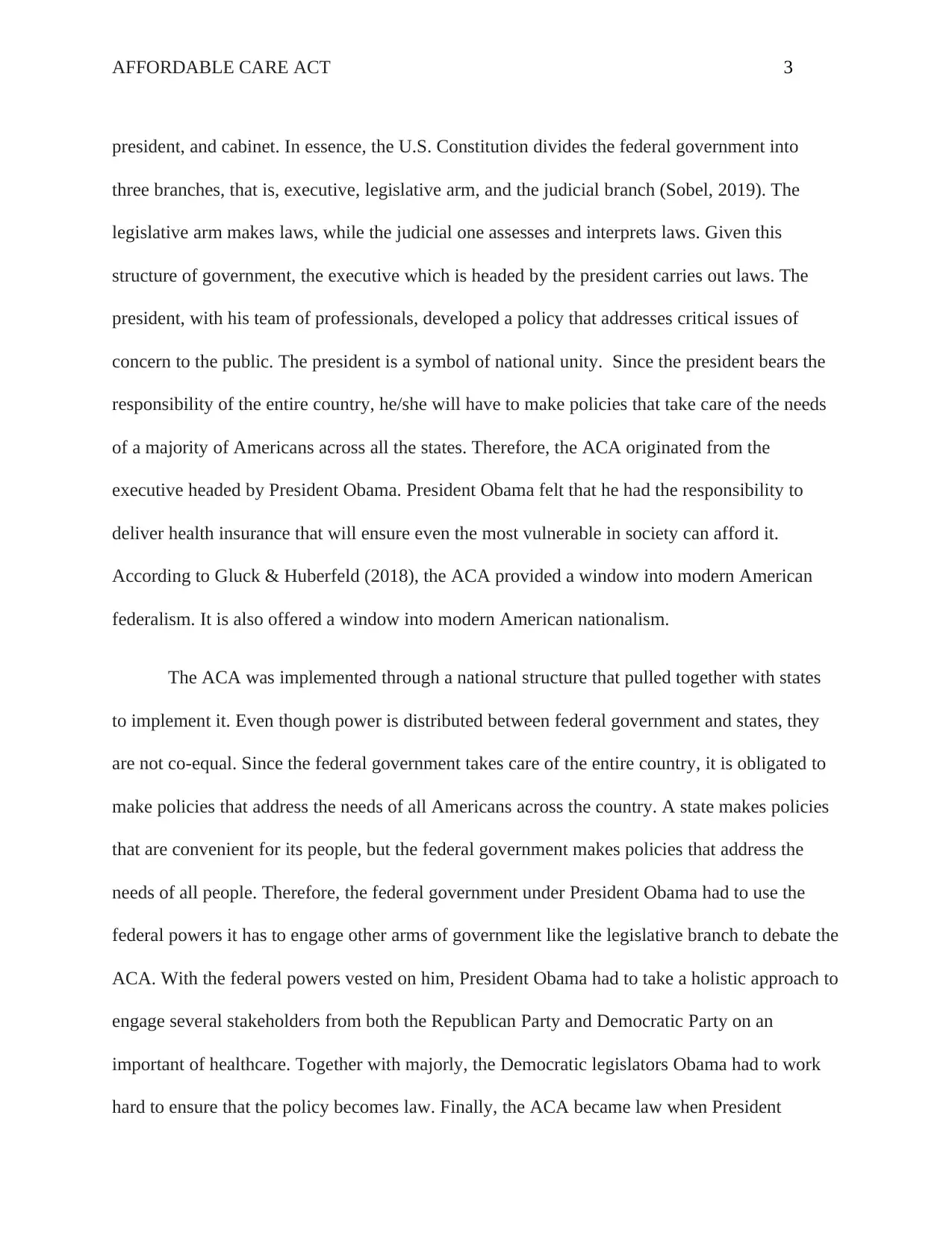
AFFORDABLE CARE ACT 3
president, and cabinet. In essence, the U.S. Constitution divides the federal government into
three branches, that is, executive, legislative arm, and the judicial branch (Sobel, 2019). The
legislative arm makes laws, while the judicial one assesses and interprets laws. Given this
structure of government, the executive which is headed by the president carries out laws. The
president, with his team of professionals, developed a policy that addresses critical issues of
concern to the public. The president is a symbol of national unity. Since the president bears the
responsibility of the entire country, he/she will have to make policies that take care of the needs
of a majority of Americans across all the states. Therefore, the ACA originated from the
executive headed by President Obama. President Obama felt that he had the responsibility to
deliver health insurance that will ensure even the most vulnerable in society can afford it.
According to Gluck & Huberfeld (2018), the ACA provided a window into modern American
federalism. It is also offered a window into modern American nationalism.
The ACA was implemented through a national structure that pulled together with states
to implement it. Even though power is distributed between federal government and states, they
are not co-equal. Since the federal government takes care of the entire country, it is obligated to
make policies that address the needs of all Americans across the country. A state makes policies
that are convenient for its people, but the federal government makes policies that address the
needs of all people. Therefore, the federal government under President Obama had to use the
federal powers it has to engage other arms of government like the legislative branch to debate the
ACA. With the federal powers vested on him, President Obama had to take a holistic approach to
engage several stakeholders from both the Republican Party and Democratic Party on an
important of healthcare. Together with majorly, the Democratic legislators Obama had to work
hard to ensure that the policy becomes law. Finally, the ACA became law when President
president, and cabinet. In essence, the U.S. Constitution divides the federal government into
three branches, that is, executive, legislative arm, and the judicial branch (Sobel, 2019). The
legislative arm makes laws, while the judicial one assesses and interprets laws. Given this
structure of government, the executive which is headed by the president carries out laws. The
president, with his team of professionals, developed a policy that addresses critical issues of
concern to the public. The president is a symbol of national unity. Since the president bears the
responsibility of the entire country, he/she will have to make policies that take care of the needs
of a majority of Americans across all the states. Therefore, the ACA originated from the
executive headed by President Obama. President Obama felt that he had the responsibility to
deliver health insurance that will ensure even the most vulnerable in society can afford it.
According to Gluck & Huberfeld (2018), the ACA provided a window into modern American
federalism. It is also offered a window into modern American nationalism.
The ACA was implemented through a national structure that pulled together with states
to implement it. Even though power is distributed between federal government and states, they
are not co-equal. Since the federal government takes care of the entire country, it is obligated to
make policies that address the needs of all Americans across the country. A state makes policies
that are convenient for its people, but the federal government makes policies that address the
needs of all people. Therefore, the federal government under President Obama had to use the
federal powers it has to engage other arms of government like the legislative branch to debate the
ACA. With the federal powers vested on him, President Obama had to take a holistic approach to
engage several stakeholders from both the Republican Party and Democratic Party on an
important of healthcare. Together with majorly, the Democratic legislators Obama had to work
hard to ensure that the policy becomes law. Finally, the ACA became law when President
⊘ This is a preview!⊘
Do you want full access?
Subscribe today to unlock all pages.

Trusted by 1+ million students worldwide

AFFORDABLE CARE ACT 4
Obama signed it. As soon as the ACA became law, the states had to implement it, and where
they needed clarity or interpretation, they had to go to court. The federal government had to work
with states to implement the ACA so that its implementation could be immediate.
ACA and Balances of Checks
The ACA is involved in the balances and checks through oversight. This policy was the
brainchild of the Obama administration. The legislative arm is made up of Congress and Senate,
which put this policy to debate and vote. If these two bodies pass the policy, the president then
signs it into law. The U.S. Congress and the Senate are involved in policy-making due to their
oversight role. The executive does not just come up with policies, and they become law. Besides,
the judiciary was equally involved in interpreting some aspects of the law regarding the ACA.
According to Rubin (2011), after the passage of the Act, some states went into court to overturn
some of its sections. Also, some lawmakers proposed amendments that would alter some parts of
ACA in favor of their states. Checks and balances mostly work in a democracy like the United
States. Therefore, the fact that legislators and some states filed lawsuits raises a fundamental role
of checks and balances in the implementation of Obamacare. When the judiciary, legislature, and
executive are involved in policy-making where those that feel unsatisfied can seek reprieve
perhaps in the judicial system, it underscores the role of checks and balances. Principally, all the
three arms of government were involved in one way to improve the ACA, so that the executive
does not merely impose it on people. The opposition to portions of the Affordable Care Act by
legislators may be politically-motivated, but it still approves the application of the principle of
checks and balances.
ACA with elections, media perceptions
Obama signed it. As soon as the ACA became law, the states had to implement it, and where
they needed clarity or interpretation, they had to go to court. The federal government had to work
with states to implement the ACA so that its implementation could be immediate.
ACA and Balances of Checks
The ACA is involved in the balances and checks through oversight. This policy was the
brainchild of the Obama administration. The legislative arm is made up of Congress and Senate,
which put this policy to debate and vote. If these two bodies pass the policy, the president then
signs it into law. The U.S. Congress and the Senate are involved in policy-making due to their
oversight role. The executive does not just come up with policies, and they become law. Besides,
the judiciary was equally involved in interpreting some aspects of the law regarding the ACA.
According to Rubin (2011), after the passage of the Act, some states went into court to overturn
some of its sections. Also, some lawmakers proposed amendments that would alter some parts of
ACA in favor of their states. Checks and balances mostly work in a democracy like the United
States. Therefore, the fact that legislators and some states filed lawsuits raises a fundamental role
of checks and balances in the implementation of Obamacare. When the judiciary, legislature, and
executive are involved in policy-making where those that feel unsatisfied can seek reprieve
perhaps in the judicial system, it underscores the role of checks and balances. Principally, all the
three arms of government were involved in one way to improve the ACA, so that the executive
does not merely impose it on people. The opposition to portions of the Affordable Care Act by
legislators may be politically-motivated, but it still approves the application of the principle of
checks and balances.
ACA with elections, media perceptions
Paraphrase This Document
Need a fresh take? Get an instant paraphrase of this document with our AI Paraphraser

AFFORDABLE CARE ACT 5
Affordable Care Act was the center of the U.S. presidential election in 2016. In many of
his political rallies, the then Presidential candidate-Trump touted that once he wins the race, he
would “repeal and replace” the Obamacare. He promised to give Americans health care that will
protect insurance companies as well as cover many people. He viewed Obamacare as a terrible
mess that needed to be repealed and replaced quickly (Béland et al., 2018). This may have
convinced those who were perhaps displeased with the ACA. Based on the article by Blendon &
Benson (2014) in the non-presidential election in 2014, some senatorial candidates both from the
Republican Party and Democratic Party raised the issue of the ACA. The Democrats talked about
the future implementation of the Act, while the Republicans voiced their disappointment in it. In
essence, health care has always been at the center of U.S. politics, where each side of the
political divide promises a cover that will cater to many Americans. Even in the now-ending
Democratic primaries, the ACA has been at the center of campaigns. When the presidential
nominees for both parties start their campaigns and debates, it is presumable that the ACA will
be discussed. Although President Trump has failed to repeal and replace it, he will likely be
asked to state his position on the ACA. Blendon & Benson (2014) indicated the approval and
disapproval of ACA and President Obama’s handling of health care in their article. This
confirms health care is a national issue that influences how some voters will vote based on their
opinions or attitudes on ACA. Nevertheless, the media, especially those that were paid to run the
ACA ads, sought to influence Americans and shape their views towards the ACA (Fowler et al.,
2017). Mostly, the media made some Americans consider the ACA as a changemaker because of
its ability to solve their health care problems.
ACA and voting
Affordable Care Act was the center of the U.S. presidential election in 2016. In many of
his political rallies, the then Presidential candidate-Trump touted that once he wins the race, he
would “repeal and replace” the Obamacare. He promised to give Americans health care that will
protect insurance companies as well as cover many people. He viewed Obamacare as a terrible
mess that needed to be repealed and replaced quickly (Béland et al., 2018). This may have
convinced those who were perhaps displeased with the ACA. Based on the article by Blendon &
Benson (2014) in the non-presidential election in 2014, some senatorial candidates both from the
Republican Party and Democratic Party raised the issue of the ACA. The Democrats talked about
the future implementation of the Act, while the Republicans voiced their disappointment in it. In
essence, health care has always been at the center of U.S. politics, where each side of the
political divide promises a cover that will cater to many Americans. Even in the now-ending
Democratic primaries, the ACA has been at the center of campaigns. When the presidential
nominees for both parties start their campaigns and debates, it is presumable that the ACA will
be discussed. Although President Trump has failed to repeal and replace it, he will likely be
asked to state his position on the ACA. Blendon & Benson (2014) indicated the approval and
disapproval of ACA and President Obama’s handling of health care in their article. This
confirms health care is a national issue that influences how some voters will vote based on their
opinions or attitudes on ACA. Nevertheless, the media, especially those that were paid to run the
ACA ads, sought to influence Americans and shape their views towards the ACA (Fowler et al.,
2017). Mostly, the media made some Americans consider the ACA as a changemaker because of
its ability to solve their health care problems.
ACA and voting
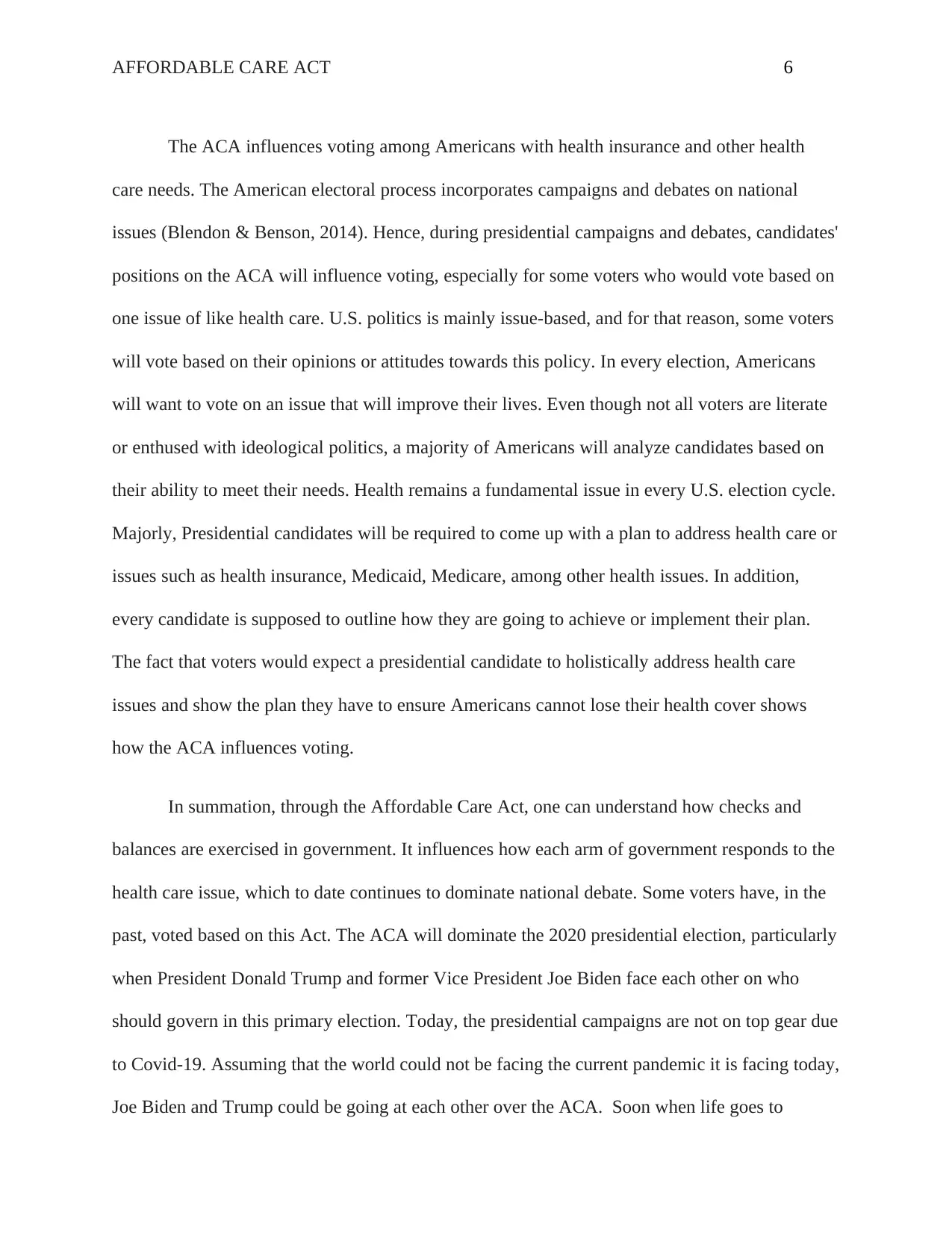
AFFORDABLE CARE ACT 6
The ACA influences voting among Americans with health insurance and other health
care needs. The American electoral process incorporates campaigns and debates on national
issues (Blendon & Benson, 2014). Hence, during presidential campaigns and debates, candidates'
positions on the ACA will influence voting, especially for some voters who would vote based on
one issue of like health care. U.S. politics is mainly issue-based, and for that reason, some voters
will vote based on their opinions or attitudes towards this policy. In every election, Americans
will want to vote on an issue that will improve their lives. Even though not all voters are literate
or enthused with ideological politics, a majority of Americans will analyze candidates based on
their ability to meet their needs. Health remains a fundamental issue in every U.S. election cycle.
Majorly, Presidential candidates will be required to come up with a plan to address health care or
issues such as health insurance, Medicaid, Medicare, among other health issues. In addition,
every candidate is supposed to outline how they are going to achieve or implement their plan.
The fact that voters would expect a presidential candidate to holistically address health care
issues and show the plan they have to ensure Americans cannot lose their health cover shows
how the ACA influences voting.
In summation, through the Affordable Care Act, one can understand how checks and
balances are exercised in government. It influences how each arm of government responds to the
health care issue, which to date continues to dominate national debate. Some voters have, in the
past, voted based on this Act. The ACA will dominate the 2020 presidential election, particularly
when President Donald Trump and former Vice President Joe Biden face each other on who
should govern in this primary election. Today, the presidential campaigns are not on top gear due
to Covid-19. Assuming that the world could not be facing the current pandemic it is facing today,
Joe Biden and Trump could be going at each other over the ACA. Soon when life goes to
The ACA influences voting among Americans with health insurance and other health
care needs. The American electoral process incorporates campaigns and debates on national
issues (Blendon & Benson, 2014). Hence, during presidential campaigns and debates, candidates'
positions on the ACA will influence voting, especially for some voters who would vote based on
one issue of like health care. U.S. politics is mainly issue-based, and for that reason, some voters
will vote based on their opinions or attitudes towards this policy. In every election, Americans
will want to vote on an issue that will improve their lives. Even though not all voters are literate
or enthused with ideological politics, a majority of Americans will analyze candidates based on
their ability to meet their needs. Health remains a fundamental issue in every U.S. election cycle.
Majorly, Presidential candidates will be required to come up with a plan to address health care or
issues such as health insurance, Medicaid, Medicare, among other health issues. In addition,
every candidate is supposed to outline how they are going to achieve or implement their plan.
The fact that voters would expect a presidential candidate to holistically address health care
issues and show the plan they have to ensure Americans cannot lose their health cover shows
how the ACA influences voting.
In summation, through the Affordable Care Act, one can understand how checks and
balances are exercised in government. It influences how each arm of government responds to the
health care issue, which to date continues to dominate national debate. Some voters have, in the
past, voted based on this Act. The ACA will dominate the 2020 presidential election, particularly
when President Donald Trump and former Vice President Joe Biden face each other on who
should govern in this primary election. Today, the presidential campaigns are not on top gear due
to Covid-19. Assuming that the world could not be facing the current pandemic it is facing today,
Joe Biden and Trump could be going at each other over the ACA. Soon when life goes to
⊘ This is a preview!⊘
Do you want full access?
Subscribe today to unlock all pages.

Trusted by 1+ million students worldwide

AFFORDABLE CARE ACT 7
normal, Trump will, in all probability, accuse Democrats of blocking repeal and replace strategy
to bring the ACA to death. Ostensibly, Joe Biden would address how he would improve the Act
to ensure that the objectives of the policy are implemented further. The Affordable Care Act
addresses health care issues that are essential to Americans and affirms the competence of the
Obama-led government in making egalitarian policies.
normal, Trump will, in all probability, accuse Democrats of blocking repeal and replace strategy
to bring the ACA to death. Ostensibly, Joe Biden would address how he would improve the Act
to ensure that the objectives of the policy are implemented further. The Affordable Care Act
addresses health care issues that are essential to Americans and affirms the competence of the
Obama-led government in making egalitarian policies.
Paraphrase This Document
Need a fresh take? Get an instant paraphrase of this document with our AI Paraphraser
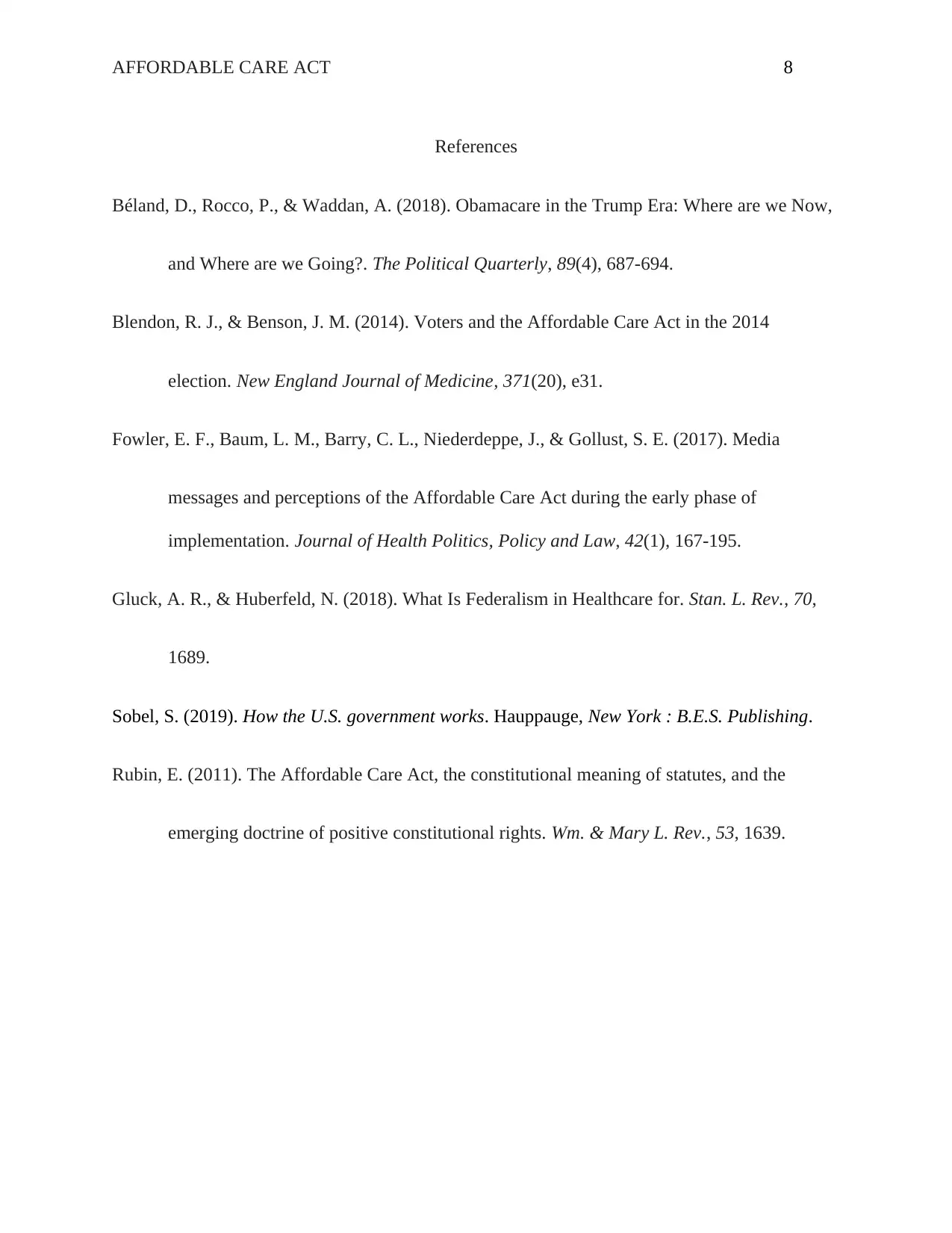
AFFORDABLE CARE ACT 8
References
Béland, D., Rocco, P., & Waddan, A. (2018). Obamacare in the Trump Era: Where are we Now,
and Where are we Going?. The Political Quarterly, 89(4), 687-694.
Blendon, R. J., & Benson, J. M. (2014). Voters and the Affordable Care Act in the 2014
election. New England Journal of Medicine, 371(20), e31.
Fowler, E. F., Baum, L. M., Barry, C. L., Niederdeppe, J., & Gollust, S. E. (2017). Media
messages and perceptions of the Affordable Care Act during the early phase of
implementation. Journal of Health Politics, Policy and Law, 42(1), 167-195.
Gluck, A. R., & Huberfeld, N. (2018). What Is Federalism in Healthcare for. Stan. L. Rev., 70,
1689.
Sobel, S. (2019). How the U.S. government works. Hauppauge, New York : B.E.S. Publishing.
Rubin, E. (2011). The Affordable Care Act, the constitutional meaning of statutes, and the
emerging doctrine of positive constitutional rights. Wm. & Mary L. Rev., 53, 1639.
References
Béland, D., Rocco, P., & Waddan, A. (2018). Obamacare in the Trump Era: Where are we Now,
and Where are we Going?. The Political Quarterly, 89(4), 687-694.
Blendon, R. J., & Benson, J. M. (2014). Voters and the Affordable Care Act in the 2014
election. New England Journal of Medicine, 371(20), e31.
Fowler, E. F., Baum, L. M., Barry, C. L., Niederdeppe, J., & Gollust, S. E. (2017). Media
messages and perceptions of the Affordable Care Act during the early phase of
implementation. Journal of Health Politics, Policy and Law, 42(1), 167-195.
Gluck, A. R., & Huberfeld, N. (2018). What Is Federalism in Healthcare for. Stan. L. Rev., 70,
1689.
Sobel, S. (2019). How the U.S. government works. Hauppauge, New York : B.E.S. Publishing.
Rubin, E. (2011). The Affordable Care Act, the constitutional meaning of statutes, and the
emerging doctrine of positive constitutional rights. Wm. & Mary L. Rev., 53, 1639.
1 out of 8
Related Documents
Your All-in-One AI-Powered Toolkit for Academic Success.
+13062052269
info@desklib.com
Available 24*7 on WhatsApp / Email
![[object Object]](/_next/static/media/star-bottom.7253800d.svg)
Unlock your academic potential
Copyright © 2020–2025 A2Z Services. All Rights Reserved. Developed and managed by ZUCOL.





